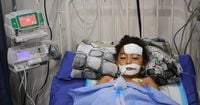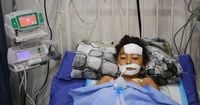The Shorbasi family, like many others in Gaza City, had just begun to breathe a little easier under the fragile ceasefire that took effect on October 10, 2025. Their severely damaged home stood as a testament to the devastation wrought by two years of war, but the brief lull in fighting offered a sliver of hope. That hope was shattered on October 24, when a sudden explosion outside their building left their six-year-old twins, Yahya and Nabila, bleeding on the ground.
According to the Associated Press, the twins had found a round object while playing in the rubble near their home. It looked harmless—"It was like a toy," their grandfather, Tawfiq Shorbasi, told reporters at Shifa hospital. But one touch was all it took for the unexploded ordnance to detonate. The blast sent Yahya and Nabila flying in opposite directions, leaving both children with life-threatening injuries.
Yahya was rushed to Shifa hospital, his right arm and leg tightly wrapped in bandages. Nabila, meanwhile, was treated at Patient’s Friends hospital for a bandaged forehead and shrapnel wounds that freckled her face. The twins’ injuries were severe: a lost hand, a hole in the bowel, broken bones, and the potential loss of a leg. As their grandfather fought back tears, he confessed, "We’ve just returned last week. Their lives have been ruined forever."
Dr. Harriet, a British emergency physician and pediatrician working in Gaza, described the twins’ ordeal as all too common. She told the Associated Press, "Now it’s just a waiting game so I hope that they both survive, but at this point in time I can’t say, and this is a common recurrence." The doctor, who declined to give her last name due to employer restrictions, added that the children’s recovery was far from certain given Gaza’s chronic shortages of medicine and medical supplies.
The family had only recently returned to their home after the ceasefire, hoping to reclaim a sense of normalcy. But the dangers lurking in the rubble are ever-present. Gaza City, the focus of the final Israeli military offensive before the ceasefire deal between Israel and Hamas, is now a landscape of shattered buildings and hidden threats. The explosion that wounded the twins occurred outside a multistory residential building, its steps scarred by a small hole in the concrete—the only visible sign of the deadly device that changed their lives.
As the Shorbasi family’s tragedy unfolded, hundreds of thousands of Palestinians were making similar journeys back to what remained of their homes. The ceasefire, while welcomed, has not ended the suffering. Many returnees sift through debris not only for their belongings but for the bodies of loved ones unreachable until now. According to Gaza’s Health Ministry, five children were wounded by unexploded ordnance over the past week alone, including one incident in the southern city of Khan Younis. Two other children, Yazan and Jude Nour, were injured on October 23 while inspecting their home in Gaza City.
Dr. Harriet summed up the grim reality: "This is the death trap. We’re talking about a ceasefire, but the killing hasn’t stopped."
The threat of unexploded ordnance is not new, but it has become more acute as people return home. Luke Irving, head of the U.N. Mine Action Service (UNMAS) in the Palestinian territories, warned at a recent United Nations briefing that "explosive risk is incredibly high" for both aid workers and displaced Palestinians. As of October 7, 2025, UNMAS had documented at least 52 Palestinians killed and 267 others wounded by unexploded ordnance since the war began—numbers the agency believes are likely much higher in reality. During the current ceasefire alone, UNMAS teams have found 560 unexploded ordnance items, with many more believed to be buried under the rubble.
The scale of devastation in Gaza defies easy comprehension. The U.N. development agency estimated that the debris left behind would be enough to build 13 giant pyramids in Egypt or fill New York’s Central Park to a depth of about 40 feet. Two years of relentless fighting have left up to 60 million tons of debris scattered across the Strip. The latest joint estimate from the U.N., European Union, and World Bank puts the cost of rebuilding Gaza at $70 billion—a staggering sum that underscores the enormity of the challenge ahead.
Irving noted that international de-mining experts are expected to join efforts in the coming weeks, a crucial step in making Gaza safe for its residents once again. "As expected, we’re now finding more items because we’re getting out more; the teams have more access," he said, highlighting the growing urgency of the situation as more people return to areas previously vacated by the Israeli military.
The dangers are not limited to unexploded ordnance. The war has decimated Gaza’s infrastructure, leaving hospitals and essential services on the brink. The World Health Organization reported that as of October 25, Rantisi hospital was the only specialized pediatric facility left in Gaza, providing oncology, dialysis, respiratory care, and gastroenterology for children. The hospital and its surrounding area have endured repeated bombardments, with Israel declaring the city a "combat zone" and forcing thousands to evacuate.
Gaza’s Health Ministry, which operates under the Hamas-run government, reported that over 68,500 Palestinians have died in the conflict. The ministry’s casualty records are considered generally reliable by U.N. agencies and independent experts, though Israel has disputed the figures without providing its own toll. The war’s human cost is evident in every hospital ward and every pile of rubble.
For families like the Shorbasis, the future remains desperately uncertain. The twins underwent emergency surgery and, for now, their conditions have stabilized. But the road to recovery is long and fraught with obstacles, from medical shortages to the ever-present risk of new explosions. As their uncle, Ziad Al-Shorbasi, recalled the moments after the blast—"We ran outside and found the boy thrown to one side and the girl to the other"—the sense of shock and helplessness was palpable.
In the coming weeks, as international teams work to clear Gaza’s deadly debris, the hope is that stories like Yahya and Nabila’s become less common. For now, though, the scars of war are everywhere—etched into the concrete, the statistics, and the lives of Gaza’s children.

